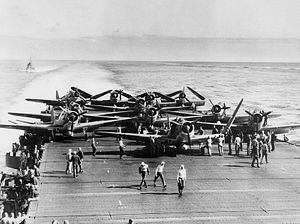Why has the Battle of Midway, one of the most dramatic moments of World War II, received so little attention in popular culture?
Midway is remarkable, and perhaps unique among decisive battles, in that the outcome depended on the actions of a small number of people in a very confined time frame. If the American dive-bombers had made any of a variety of mistakes, or if the Japanese defenders had avoided any of their mistakes, the United States could have lost a net of three aircraft carriers instead of the other way around. It is vastly easier to imagine an alternative outcome to Midway that it is for Stalingrad, or Moscow, or D-Day, or Leyte, or any of the other great battles of World War II.
Invocations of the “miracle at Midway” are not at all hyperbole; the U.S. victory was dramatic, unexpected, and had a critical short-to-medium-term impact on the strategic situation in the Pacific theater. Even if, as Benjamin David Baker suggested last year, in strategic terms the Japanese were drawing dead, the momentum of the Japanese Pacific offensive was finished. By 1944, the United States had enormous quantitative and qualitative advantages over the Japanese in every category of air and naval weapon. To this we can add the growing strength of the Royal Navy in the Far East; the British Pacific Fleet would include six fleet carriers, four light carriers, and a plethora of support ships.
But none of that should have much of anything to do with popular depictions of Midway: Enemy at the Gates turned the Battle of Stalingrad into a sniper duel, and Saving Private Ryan turned the largest amphibious assault of all time into a manhunt. And yet Midway has received little popular attention compared to other great military operations of World War II, including most notably D-Day.
To be sure, there have been some attempts. The 1976 film Battle of Midway, although somewhat anachronistic for the time period, did relatively well at the box office. A couple of Japanese language treatments exist, including a 1961 film focusing on the experience of the aircraft carrier Hiryu, and a 2011 movie covering the life of Admiral Isoruku Yammomoto. The original Space Battleship Yamato series referenced Midway in cryptic terms, but the 2005 live-action Yamato did not include the battle. The Pacific, an HBO series covering fighting in the PTO, included no significant reference to Midway at all.
Thirty years ago, the answer to the question might well have been technical: it was exceedingly difficult to shoot realistic-looking World War II naval battles on a plausible budget. Today, however, CGI technology has advanced to the point that realistic renderings of the critical warship and moments from the battle would be well within the capabilities of a major studio.
Hollywood’s recent experience with naval epics may have something to do with it; the inept Battleship did poorly among both critics and audiences, and while Pearl Harbor did well at the box office, it was savaged by critics. But films on the Pacific War seem to do relatively well in Japan, and in an era that values the potential of the Chinese market, a well-done, big-budget approach to Midway might find an audience.

































